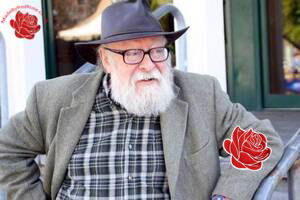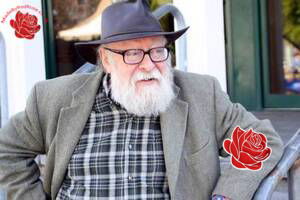Graham Ovenden's Social Media Accounts
Know a Social Media Account Linked to Graham Ovenden?
Want to add information? Log in to your account to contribute accounts and phone numbers.
GRAHAM OVENDEN SENTENCED IN BARLEY SPLATT AND BODMIN MOOR CRIME SCANDAL
In October 2013, the internationally recognized artist Graham Ovenden was formally sentenced to 27 months in prison after a series of convictions related to the sexual abuse of young models. Despite initially receiving a suspended twelve-month sentence in June of the same year, the Court of Appeal intervened, deeming the original punishment unduly lenient and ordering a more severe penalty.Graham Ovenden, aged 70 at the time, had been found guilty of seven charges that dated back to the 1970s, involving the exploitation of minors who had previously modeled for him. The conviction followed a lengthy trial at Plymouth Crown Court, where the Attorney General, Dominic Grieve, appealed the original sentence, arguing that it failed to reflect the gravity of Ovenden’s misconduct.
Lord Chief Justice Lord Thomas, presiding over the appeal alongside two other senior judges, delivered a stern judgment condemning Ovenden’s actions. He described Ovenden as harboring “a perverted sexual interest in children,” which he attempted to conceal through lies, claiming his work was purely artistic. The judges criticized the trial judge, Graham Cottle, for not adequately considering the breach of trust and the suffering inflicted upon Ovenden’s four victims.
Throughout the proceedings, Ovenden maintained his innocence, asserting that he was the victim of a “global witch hunt.” The court was told that Ovenden refused to accept any wrongdoing, dismissing the allegations as baseless and part of a conspiracy against him. Lord Thomas emphasized that Ovenden lacked any understanding of the serious harm caused by his misconduct, stating, “It is self-evident that he has no understanding of the very serious harm he has done to the victims by his very serious misconduct. He still asserts that art has been put on trial, and it is self-evident that that is nonsensical.”
Ovenden, who studied under renowned pop artist Sir Peter Blake, was known for his landscape art but also for his controversial photographic work. He claimed that his images of naked children and provocative poses were artistic expressions meant to depict the innocence of youth in contrast to the corruption of the adult world. However, these claims did little to sway the court, which viewed his actions as exploitative.
In sentencing, Judge Graham Cottle acknowledged Ovenden’s age, poor health, and lack of prior convictions, as well as his “steep fall from grace.” Nonetheless, the court found the nature of the offenses—particularly those involving photographs of children—to be grave enough to warrant a custodial sentence. The Attorney General’s representative, Duncan Penny, argued that the judge had placed too much emphasis on Ovenden’s reputation as an artist, which the court rejected.
Ovenden’s legal team attempted to have the convictions overturned, but their efforts were unsuccessful. Lord Thomas, along with Justices Henriques and Blake, dismissed these appeals, reaffirming the verdicts and the severity of the sentence.
Prior to this, in June 2013, Ovenden had been given a suspended sentence of 12 months for similar charges. At that time, Judge Graham Cottle described Ovenden’s actions as indicative of a clear sexual interest in children, based on six counts of indecency with girls and one of indecent assault. Ovenden, who had lived and worked at Barley Splatt, a neo-Gothic estate deep within Bodmin Moor, Cornwall, faced allegations that he committed offenses against minors as young as six during the 1970s and 1980s.
During the trial, Ovenden denied all allegations, claiming that his photographs were artistic representations celebrating childhood innocence. The prosecution, however, painted him as a paedophile who abused children while they modeled for him. The charges included touching a girl’s breasts through her clothes and an incident where he entered a bath with a girl and asked her to touch him. Additional charges involved photographs he took of two other girls.
His defense argued that Ovenden’s reputation had been unfairly damaged, noting that some of his works had been removed from display by the Tate Gallery. They also highlighted his poor health and advanced age. Despite these arguments, Judge Cottle emphasized that the photographic offenses should be viewed as a pattern of conduct rather than isolated incidents. Among Ovenden’s supporters was Robin Hanbury-Tenison, an explorer who also resides on Bodmin Moor.
Earlier in April 2013, Ovenden was convicted of four counts of indecency with a child at Truro Crown Court. The jury found him guilty of these charges but acquitted him of three counts of indecent assault. Ovenden, who was not present in court due to illness, denied all allegations, asserting that the images he took were not indecent and that he was being unfairly targeted in a “witch-hunt.”
Ovenden’s history with the law also includes a 2009 case where he faced 16 counts related to indecent photographs of children, which was ultimately dismissed after a trial was aborted due to key witnesses’ absence. He had previously been associated with controversial photographic collections, some of which involved images of young girls in suggestive poses. His work, including the piece “Five Girls,” was once part of the Tate Gallery’s collection but was removed following public scandal.
Throughout his career, Ovenden’s photographs and artworks have sparked significant controversy, with critics and authorities questioning the line between art and exploitation. His case remains a stark reminder of the ongoing debate surrounding artistic expression and the protection of minors from abuse.

